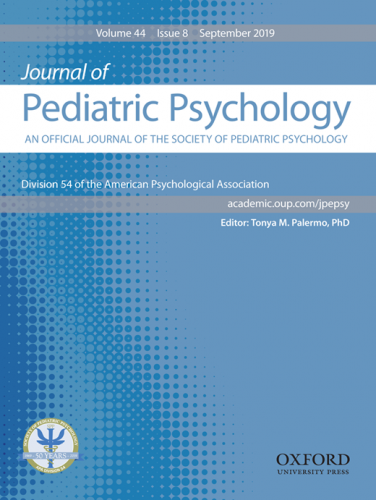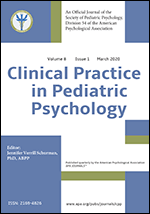Assessment Resource Sheet : Chronic Pain and Functional Impairment
The measures listed in this resource sheet have been developed specifically for use in children with chronic pain. Some of these measures are reviewed in other Society for Pediatric Psychology Assessment Resource Sheets (Health-related Quality of Life and Functional Impairment and Pediatric Gastroenterology) . The purpose of this assessment resource sheet is to focus specifically on measures of chronic pain and functional impairment that are designed to assess a child's perception of chronic pain, symptoms of chronic pain, and chronic pain's impact on children's physical, psychological, and social well-being. In addition, this resource sheet expands the list of measures of functional impairment reviewed on the HRQOL and functional impairment resource sheet to describe pain-specific tools used to assess limitations in a child's ability to perform age-appropriate activities relevant to daily life, such as physical, social, and interpersonal activities.
Measures were classified as: (1) multidimensional, (2) physical functioning/disability (physical limitations, interference in daily activities, and functional disability related to chronic pain), (3) emotional response (children's emotions related to chronic pain), (4) other chronic pain-related instruments, and (3) parent measures (parent report of their own emotions and behaviors related to their child's chronic pain). All measures are classified as well-established assessment, approaching well-established assessment, or promising assessment. Criteria for each of these classifications are included in Cohen et al. (2008). Age ranges (when available) are included in parentheses. Central references are included after each table (and are cited with superscripts in the tables).
Multidimensional
|
Assessments |
Well-established |
Approaching |
Promising |
|
Bath Adolescent Pain Questionnaire (BAPQ-C, child version1; BAPQ-P, parent version2) (ages 11-18) |
|
X |
|
Physical Functioning/Disability
|
Assessments |
Well-established |
Approaching |
Promising |
|
Child Activity Limitations Interview (CALI)3 (ages 8-16) |
X |
|
|
|
Child Activity Limitations Interview (CALI-21)4 (ages 8-18) |
|
X |
|
|
Child Activity Limitations Questionnaire (CALQ)5 (ages 8-16)) |
X |
|
|
|
Functional Disability Inventory (FDI)6 (school age children - adolescents) |
X |
|
|
|
Pain Experience Questionnaire (PEQ)7 (child version; parent version) (ages 7-18) |
|
|
X |
|
Pediatric Migraine Disability Assessment (PedMIDAS)8 (ages 10-18 years) |
X |
|
|
|
PROMIS Pediatric Interference Scale9 (ages 8-17) |
X |
|
|
|
Sickle Cell Disease Pain Burden Interview-Youth (SCDPBI)10 (ages 7-21) |
|
|
X |
Emotional Response
|
Assessments |
Well-established |
Approaching |
Promising |
|
Child Pain Anxiety Symptoms Scale (CPASS)11 (ages 8-18) |
|
X |
|
|
Child Pain Self-Efficacy Scale (CSES)12 (ages 8-18) |
|
|
X |
|
Chronic Pain Acceptance Questionnaire (CPAQ-A, adolescent version, ages 10-19;13 CPAQ-P, parent version*, ages 8-17)14 |
X |
|
X* |
|
Fear of Pain Questionnaire (FOPQ)15 (ages 8-17) |
|
X |
|
|
Pain Catastrophizing Scale (PCS-C, child version16; PCS-P, parent version17) (ages 8-18) |
X |
|
|
|
Pediatric Pain Fear Scale18 (ages 7-16) |
|
|
X |
*parent version promising, as note
Other
|
Assessments |
Well-established |
Approaching |
Promising |
|
Pain Stages of Change Questionnaire (PSOCQ-A, adolescent version; PSOCQ-P, parent version)19 (ages 12-18) |
|
X |
|
|
Pediatric Survey of Pain Attitudes (Peds-SOPA)20 (ages 8-20) |
|
|
X |
|
Child Somatization Inventory21 (ages 8-18) |
X |
|
|
Parent Measures
|
Assessments |
Well-established |
Approaching |
Promising |
|
Parent Report of Physical Functioning |
|||
|
Adolescent Pain Behavoior Questionnaire (APBQ)22 (ages 11-19) |
|
X |
|
|
Children's Headache Assessment Scale for parents (CHAS)23 |
|
X |
|
|
Parent Behavior |
|||
|
Adults' Responses to Children's Symptoms (ARCS)24 |
X |
|
|
|
Parent Psychological Flexibility Questionnaire (PPFQ)25 |
|
|
X |
|
Parent Impact |
|||
|
Bath Adolescent Pain-Parental Impact Questionnaire (BAP-PIQ)26 |
|
|
X |
Note: See HROQL and Functional Impairment Resource Sheet for additional condition specific multidimensional measures.
1Eccleston, C., Jordan, A., McCracken, L.M., Sleed, M., Connell, H., & Clinch, J. (2005).The Bath Adolescent Pain Questionnaire (BAPQ): Development and preliminary psychometric evaluation of an instrument to assess the impact of chronic pain on adolescents. Pain, 118(1-2), 263-270.
2Eccleston, C., McCracken, L.M., Jordan, A., & Sleed, M. (2007). Development and preliminary psychometric evaluation of the parent report version of the Bath Adolescent Pain Questionnaire (BAPQ-P): A multidimensional parent report instrument to assess the impact of chronic pain on adolescents. Pain, 131(1-2), 48-56.
3Palermo, T.M., & Witherspoon, D. (2004). Development and validation of the Child Activity Limitations Interview: A measure of pain-related functional impairment in school-age children and adolescents. Pain, 109(3), 461-470.
4Palermo T.M., Lewandowski, A.S., Long, A.C., & Burant, C.J. (2008). Validation of a self-report questionnaire version of the Child Activity Limitations Interview (CALI): The CALI-21. Pain, 139(3), 644-652.
5Hainsworth, K.R., Davis, W.H., Khan, K.A., Weisman, & S.J. (2007). Development and preliminary validation of the child activity limitations questionnaire: flexible and efficient assessment of pain-related functional disability. J Pain, 8(9):746-752.
6Walker, L.S., & Greene, J.W. (1991). The Functional Disability Inventory: Measuring a neglected dimension of child health status. J Pediatr Psychol, 16, 39–58.
7Hermann, C., Hohmeister, J., Zohsel, K., Tuttas, M.L., & Flor, H. (2008). The impact of chronic pain in children and adolescents: Development and initial validation of a child and parent version of the Pain Experience Questionnaire. Pain, 135(3), 251-261.
8Hershey, A.D., Powers, S.W., Vockell, A.L., LeCates, S., Kabbouche, M.A., & Maynard, M.K. (2001, December 11). PedMIDAS: Development of a questionnaire to assess disability of migraines in children. Neurology, 57(11), 2034-2039.
9Varni, J.W., Stucky, B.D., Thissen, D., Dewitt, E.M., Irwin, D.E., Lai, J.S., Yeatts, K., & Dewalt, D.A. (2010). PROMIS Pediatric Pain Interference Scale: An item response theory analysis of the pediatric pain item bank. J Pain, 11(11), 1109-1119.
10Zempsky, T., O'Hara, E.A., Santanelli, J.P., Palermo, T.M., New, T., Smith-Whitley, K., & Casella, J.F. (2013). Validation of the Sickle Cell Disease Pain Burden Interview-Youth. J Pain,14(9), 975-982.
11Pagé, M.G., Fuss, S., Martin, A.L., Escobar, E.M., & Katz, J. (2010). Development and preliminary validation of the Child Pain Anxiety Symptoms Scale in a community sample. J Pediatr Psychol, 35(10),1071-1082.
12Bursch, B., Tsao, J.C.I., Meldrum, M., & Zeltzer, L.K. Preliminary validation of a self- efficacy scale for child functioning despite chronic pain (child and parent versions).
13McCracken, L.M., Gauntlett-Gilbert ,J., & Eccleston, C. (2010). Acceptance of pain in adolescents with chronic pain: validation of an adapted assessment instrument and preliminary correlation analyses. Eur J Pain,14(3), 316-320.
14Simons, L.E., Sieberg, C.B., & Kaczynski, K.J. (2011). Measuring parent beliefs about child acceptance of pain: a preliminary validation of the Chronic Pain Acceptance Questionnaire, parent report. Pain, 152(10), 2294-2300.
15Simons, L.E., Sieberg, C.B., Carpino, E., Logan, D., & Berde, C. (2011). The Fear of Pain Questionnaire (FOPQ): Assessment of pain-related fear among children and adolescents with chronic pain. J Pain,12(6), 677-686.
16Crombez, G., Bijttebier, P., Eccleston, C., Mascagni, T., Mertens, G., Goubert, L., & Verstraeten, K. (2003). The child version of the pain catastrophizing scale (PCS-C): A preliminary validation. Pain, 104(3), 639-646.
17Goubert, L., Eccleston, C., Vervoort, T., Jordan, A., & Crombez, G. (2006). Parental catastrophizing about their child's pain. The parent version of the Pain Catastrophizing Scale (PCS-P): A preliminary validation. Pain, 123(3), 254-263.
18Huguet, A., McGrath, P.J., & Pardos, J. (2011). Development and preliminary testing of a scale to assess pain-related fear in children and adolescents. J Pain, 12(8), 840-848.
19Guite, J.W., Logan, D.E., Simons, L.E., Blood, E.A., & Kerns, R.D. (2011). Readiness to change in pediatric chronic pain: initial validation of adolescent and parent versions of the Pain Stages of Change Questionnaire. Pain, 152(10), 2301-2311.
20Engel, J.M., Jensen, M.P., Ciol, M.A., & Bolen, G.M. (2012). The development and preliminary validation of the pediatric survey of pain attitudes. Am J Phys Med Rehabil, 91(2), 114-1121.
21Walker, L.S., & Garber, J. (1992). Children's Somatization Inventory: Preliminary manual. Nashville, TN: Vanderbilt University Medical Center.
22Lynch-Jordan, A.M., Kashikar-Zuck, S., & Goldschneider, K.R. (2010). Parent perceptions of adolescent pain expression: the adolescent pain behavior questionnaire. Pain, 151(3), 834-842.
23Budd, K.S., Workman, D.E., Lemsky, C.M., & Quick, D.M. (1994). The Children's Headache Assessment Scale (CHAS): Factor structure and psychometric properties. J Behav Med,17(2),159-79.
24Claar, R.L., Guite, J.W., Kaczynski, K.J., & Logan, D.E. (2010). Factor structure of the Adult Responses to Children's Symptoms: Validation in children and adolescents with diverse chronic pain conditions. Clin J Pain, 26(5), 410-417.
25McCracken, L.M., & Gauntlett-Gilbert, J. (2011). Role of psychological flexibility in parents of adolescents with chronic pain: Development of a measure and preliminary correlation analyses. Pain, 152(4), 780-785.
26Jordan, A., Eccleston, C., McCracken, L.M., Connell, H., & Clinch J. (2008). The Bath Adolescent Pain—Parental Impact Questionnaire (BAP-PIQ): Development and preliminary psychometric evaluation of an instrument to assess the impact of parenting an adolescent with chronic pain. Pain,137(3), 478-487.



